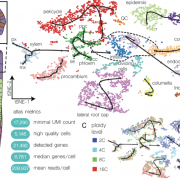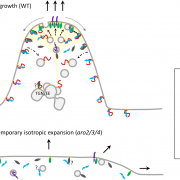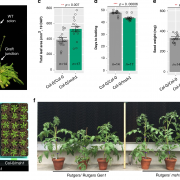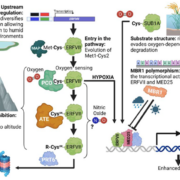Oxygen supply dictates growth and metabolism in young leaves
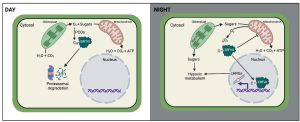 When thinking of hypoxia or low oxygen in plants, the image that often comes to mind is one of flooding stress. However, it’s not just plants exposed to excess of water that face hypoxia. Even in growing plants, hypoxia sensing and the existence of hypoxic niches play a vital role in their development. Young, actively growing leaves have different metabolic needs compared to mature leaves, characterized by high respiration rates and thus high oxygen consumption. Yet a functional connection between internal oxygen sensing and a metabolic shift in developing plants is unexplored. In this intriguing study, Triozzi et al. uncovered the existence of cyclic hypoxia in young leaves. The authors found that the expression of hypoxia-responsive genes (HRGs) exhibits diurnal fluctuations, with peak expression at night. Using a combination of genetic and pharmacological approaches and transcriptional reporters, in combination with oxygen-modified atmosphere treatments, they demonstrated that diurnal variations in HRGs occur independently of light and clock inputs and are actually regulated by oxygen levels. Through the measurement of internal oxygen levels, the authors reveal that young leaves, and not old leaves, experience a drop in oxygen during the night. This nocturnal oxygen dip and the associated hypoxia signaling cascade, which is ERFVII-dependent, causes a shift in metabolism from aerobic to hypoxic metabolism, which is important to modulate leaf growth at at different times of the day. (Summary by Thomas Depaepe @thdpaepe) Mol. Plant 10.1016/j.molp.2024.01.006
When thinking of hypoxia or low oxygen in plants, the image that often comes to mind is one of flooding stress. However, it’s not just plants exposed to excess of water that face hypoxia. Even in growing plants, hypoxia sensing and the existence of hypoxic niches play a vital role in their development. Young, actively growing leaves have different metabolic needs compared to mature leaves, characterized by high respiration rates and thus high oxygen consumption. Yet a functional connection between internal oxygen sensing and a metabolic shift in developing plants is unexplored. In this intriguing study, Triozzi et al. uncovered the existence of cyclic hypoxia in young leaves. The authors found that the expression of hypoxia-responsive genes (HRGs) exhibits diurnal fluctuations, with peak expression at night. Using a combination of genetic and pharmacological approaches and transcriptional reporters, in combination with oxygen-modified atmosphere treatments, they demonstrated that diurnal variations in HRGs occur independently of light and clock inputs and are actually regulated by oxygen levels. Through the measurement of internal oxygen levels, the authors reveal that young leaves, and not old leaves, experience a drop in oxygen during the night. This nocturnal oxygen dip and the associated hypoxia signaling cascade, which is ERFVII-dependent, causes a shift in metabolism from aerobic to hypoxic metabolism, which is important to modulate leaf growth at at different times of the day. (Summary by Thomas Depaepe @thdpaepe) Mol. Plant 10.1016/j.molp.2024.01.006


